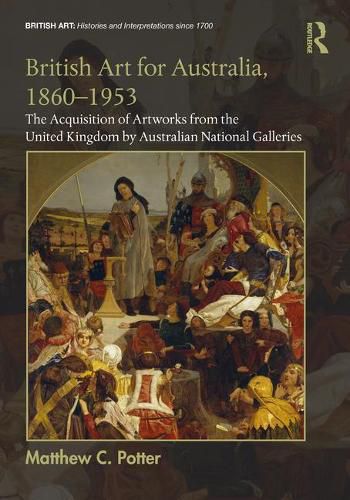Readings Newsletter
Become a Readings Member to make your shopping experience even easier.
Sign in or sign up for free!
You’re not far away from qualifying for FREE standard shipping within Australia
You’ve qualified for FREE standard shipping within Australia
The cart is loading…






Traditional postcolonial scholarship on art and imperialism emphasises tensions between colonising cores and subjugated peripheries. The ties between London and British white settler colonies have been comparatively neglected. Artworks not only reveal the controlling intentions of imperialist artists in their creation but also the uses to which they were put by others in their afterlives. In many cases they were used to fuel contests over cultural identity which expose a mixture of rifts and consensuses within the British ranks which were frequently assumed to be homogeneous. British Art for Australia, 1860-1953: The Acquisition of Artworks from the United Kingdom by Australian National Galleries represents the first systematic and comparative study of collecting British art in Australia between 1860 and 1953 using the archives of the Australian national galleries and other key Australian and UK institutions. Multiple audiences in the disciplines of art history, cultural history, and museology are addressed by analysing how Australians used British art to carve a distinct identity, which artworks were desirable, economically attainable, and why, and how the acquisition of British art fits into a broader cultural context of the British world.
It considers the often competing roles of the British Old Masters (e.g. Romney and Constable), Victorian (e.g. Madox Brown and Millais), and modern artists (e.g. Nash and Spencer) alongside political and economic factors, including the developing global art market, imperial commerce, Australian Federation, the First World War, and the coming of age of the Commonwealth.
$9.00 standard shipping within Australia
FREE standard shipping within Australia for orders over $100.00
Express & International shipping calculated at checkout
Traditional postcolonial scholarship on art and imperialism emphasises tensions between colonising cores and subjugated peripheries. The ties between London and British white settler colonies have been comparatively neglected. Artworks not only reveal the controlling intentions of imperialist artists in their creation but also the uses to which they were put by others in their afterlives. In many cases they were used to fuel contests over cultural identity which expose a mixture of rifts and consensuses within the British ranks which were frequently assumed to be homogeneous. British Art for Australia, 1860-1953: The Acquisition of Artworks from the United Kingdom by Australian National Galleries represents the first systematic and comparative study of collecting British art in Australia between 1860 and 1953 using the archives of the Australian national galleries and other key Australian and UK institutions. Multiple audiences in the disciplines of art history, cultural history, and museology are addressed by analysing how Australians used British art to carve a distinct identity, which artworks were desirable, economically attainable, and why, and how the acquisition of British art fits into a broader cultural context of the British world.
It considers the often competing roles of the British Old Masters (e.g. Romney and Constable), Victorian (e.g. Madox Brown and Millais), and modern artists (e.g. Nash and Spencer) alongside political and economic factors, including the developing global art market, imperial commerce, Australian Federation, the First World War, and the coming of age of the Commonwealth.